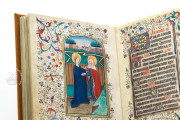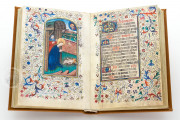The Offiziolo of Maria Antonietta of Savoia is one of the most remarkable Renaissance manuscripts by Willem Vrelant. The codex, also known as Officium Beatae Mariae Virginis, was written and illuminated in the second half of the 15th century and features 13 beautifully illuminated miniatures, 172 decorated initials, 13 illuminated initials.
The Offiziolo of Maria Antonietta of Savoia and Willelm Vrelant
Written in Latin, the manuscript features an outstanding iconographic apparatus in which the hand of the Flemish master Willelm Vrelant is to be recognized. The artist, author of countless renown works, exhibits his fondness for richly decorated borders which feature elaborate intertwining branches, leaves and flowers.
Vrelant makes use of shiny and vivid colors embellished by the use of gold. Some of the most significant miniatures of the manuscript are the Annunciation (f. 1v), the Crucifixion (f. 8v), and the Pentecost (f. 13v).
"Vintage" Miniatures
The miniature of the Annunciation (f. 1v) is probably the most significant as, compared to the other illustrations, it dates to a century earlier. This was common practice as a manuscript opening with an old miniature was considered to be more valuable.
It has been suggested that the miniature belongs to the Avignon area during its role as papal residence, the heart of European culture of Trecento, where cultural and artistic development thrived among artists of all kind.
Life of the Manuscript: from the Church to the King
The life of the manuscript appears to be accounted for only from the second half of the 18th century, in the year 1764, when this elegant manuscript was purchased by Carlo Emanuele III from the ecclesiastic figure of Sigismond Touttemps for the Biblioteca dell’Archivio Regio.
An Italian Recipient
Although the commissioner of the Offiziolo of Maria Antonietta of Savoia remains unknown, there are some leads as to who the manuscript was made for. Indeed, on the first leaf of the codex we read “incipit officium beate virginis ad usum romane curie”, an important indication that the manuscript was made for a high representative of the church in Italy.
Confirming the suggestion of an Italian recipient is also the calendar mainly featuring names of Italian saints.
Gothic Script
The Offiziolo of Maria Antonietta of Savoia features a beautiful example of Gothic script, which features tall, narrow letters formed by sharp and angular lines.
Unfortunately, like many medieval manuscripts, the Offiziolo of Maria Antonietta lost its original binding and is currently bound in 17th century goatskin binding.
We have 1 facsimile edition of the manuscript "Offiziolo of Maria Antonietta of Savoia": Offiziolo di Maria Antonietta di Savoia facsimile edition, published by Imago, 2005
Request Info / Price






